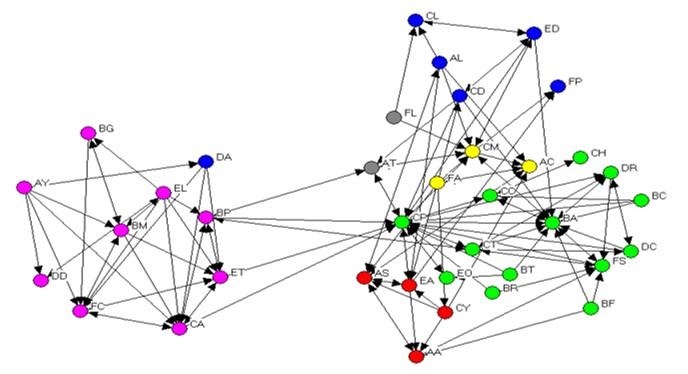KM Component 25 – Social Network Analysis

Stan Garfield
Social network analysis is mapping and measuring relationships and flows between people, groups, organizations, computers or other information/knowledge processing entities.
The nodes in the network are the people and groups, while the links show relationships or flows between the nodes. SNA provides both a visual and a mathematical analysis of human relationships. (Source: Valdis Krebs)
Social network analysis (SNA) can be used to improve communities, identify missing links, and improve connections between groups.
In a KM implementation plan, identify all groups that need to connect, and include boundary spanning as a required knowledge flow. The higher the level of connectedness you can achieve, the more knowledge will flow between groups. You can use social network analysis to help determine the current state of social networks and to identify boundary spanning opportunities.
SNA can be used to identify people who are linked, but who may not be part of a formal community. These people can be invited join a community relevant to them.
In The Hidden Power of Social Networks: Understanding How Work Really Gets Done in Organizations, Rob Cross and Andrew Parker describe the benefits of using SNA, including:
- Improving effectiveness of functions or business units. SNA can help leaders assess the extent to which collaborations throughout their unit are aligned with strategic objectives and generating measurable business value.
- Promoting lateral coordination throughout an organization. SNA can help identify opportunities in networks that span functions, geographies, or process steps.
- Driving innovation in new product development, R&D, or market-facing functions. SNA can isolate how and where leveraging expertise in a network will either support or impede innovation efforts.
- Facilitating large-scale change or merger integration. SNA pre-change can identify key players to work through and retain. During the change, it can inform key interventions. After the change, it can ensure appropriate integration.
- Supporting Communities of Practice. SNA can help to rapidly form and improve effectiveness of communities by working through the network to more efficiently improve collaboration and business results.
- Forming strategic partnerships or assessing client connectivity. SNA can illuminate the effectiveness of external ties to strategic partners or clients in terms of information flow, knowledge transfer, and decision-making.
- Talent management and leadership development. SNA can help improve leadership effectiveness and replicate high performance throughout an organization.
You can use SNA to bridge silos, create awareness of distributed expertise distributed in the network, and identify and draw in peripheral network members. In Building Smart Communities through Network Weaving, Valdis Krebs and June Holley assert that “improved connectivity is created through an iterative process of knowing the network and knitting the network.” SNA enables you to know the network so that you can then proceed to weave new members into it.
Valdis advises to “connect on your similarities and profit from your diversities.” By using SNA to identify those with both similarities and differences, and using this information to better connect those people, you can enable greatly improved collaboration and knowledge flow within and across organizations. SNA is especially useful in understanding and improving the social networks of individuals, in enabling more effective collaboration by ensuring that the right people are included, and in starting, building, and extending communities.
Two related processes are Organizational Network Analysis (ONA) and Value Network Analysis (VNA). According to Patti Anklam, “ONA comprises social network analysis (SNA) tools that provide managers with visual maps and quantitative data that indicate the current patterns of connection within and across groups in an organization. ONA is proving to be an exceptional tool for providing a baseline against which to measure changes in collaboration and connectivity during times of organizational change. I use ONA with clients to help them assess the current state of connectivity in their organizations and reframe their strategies in terms of network capacity and diversity.”
Patti stated, “VNA brings insight and perspective by creating a map of the interactions — tangible and intangible — among the functional groups in an organization’s business processes. VNA puts the network lens on a value chain. I use it to help clients see the important patterns in knowledge flow and collaboration so as to help target the introduction of methods and tools to support enhanced collaboration and innovation.”
Verna Allee defined VNA as “a business modeling methodology that visualizes business activities and sets of relationships from a dynamic whole systems perspective.” She further stated, “the Value Network approach helps individuals and work groups better manage their interactions and address operational issues, such as balancing workflows or improving communication. It also scales up to the business level to help forge stronger value-creating linkages with strategic partners and improve stakeholder relationships.”
Here is an example of the results of a social network analysis:

For more, read the works of these thought leaders:

Stan Garfield
Please enjoy Stan’s additional blog posts offering advice and insights drawn from many years as a KM practitioner. You may also want to download a copy of his book, Proven Practices for Implementing a Knowledge Management Program, from Lucidea Press. And learn about Lucidea’s Inmagic Presto and SydneyEnterprise with KM capabilities to support successful knowledge curation and sharing.
Similar Posts
Lucidea’s Lens: Knowledge Management Thought Leaders Part 68 – Chris Collison
KM Thought Leader Chris Collison works with a variety of organizations, helping them improve performance by discovering and sharing what they know.
Why Senior Leadership by Example is Important for Knowledge Management Success
Getting C-level advocacy for KM is critical for success; senior leaders should provide funding, demonstrate support, and lead by example.
Lucidea’s Lens: Knowledge Management Thought Leaders Part 67 – Shawn Callahan
KM Thought Leader Shawn Callahan helps analytically-minded executives tell stories that ultimately inspire action from employees and customers.
Lucidea’s Lens: Knowledge Management Thought Leaders Part 66 – Bob Buckman
Very few corporate CEOs directly champion knowledge management, and write about it. KM Thought Leader Bob Buckman is one of them.
Hosting service
Enjoy all of the benefits of your Lucidea solution with secure, reliable, stress free hosting
Programs & incentives
No matter your size or budget, we’ve got you covered, today and tomorrow



Leave a Comment
Comments are reviewed and must adhere to our comments policy.
0 Comments